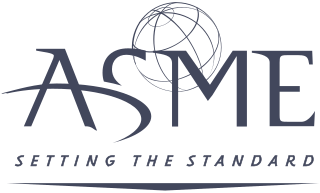
The American Society of Mechanical Engineers (ASME) is an American professional association that, in its own words, "promotes the art, science, and practice of multidisciplinary engineering and allied sciences around the globe" via "continuing education, training and professional development, codes and standards, research, conferences and publications, government relations, and other forms of outreach." ASME is thus an engineering society, a standards organization, a research and development organization, an advocacy organization, a provider of training and education, and a nonprofit organization. Founded as an engineering society focused on mechanical engineering in North America, ASME is today multidisciplinary and global.
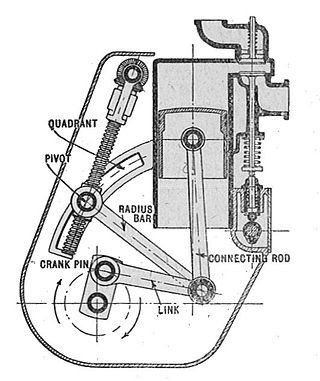
A mechanical linkage is an assembly of systems connected to manage forces and movement. The movement of a body, or link, is studied using geometry so the link is considered to be rigid. The connections between links are modeled as providing ideal movement, pure rotation or sliding for example, and are called joints. A linkage modeled as a network of rigid links and ideal joints is called a kinematic chain.
The Timoshenko Medal is an award given annually by the American Society of Mechanical Engineers (ASME) to an individual "in recognition of distinguished contributions to the field of applied mechanics."
The Daniel C. Drucker medal was instituted in 1997 by the Applied Mechanics Division of the American Society of Mechanical Engineers. The Drucker Medal is conferred in recognition of distinguished contributions to the fields of applied mechanics and mechanical engineering. The award is given in honor of Daniel C. Drucker, who was internationally known for contributions to the theory of plasticity and its application to analysis and design in metal structures. The recipient is given a medal and an honorarium.
The Max Jakob Memorial Award recognizes an 'eminent scholarly achievement and distinguished leadership' in the field of heat transfer. Awarded annually to a scholar by the American Society of Mechanical Engineers (ASME) and the American Institute of Chemical Engineers (AIChE), it is the highest honor in the field of heat transfer these professional organizations bestow.
The Hoover Medal is an American engineering prize.
The Applied Mechanics Award is an award given annually by the Applied Mechanics Division of American Society of Mechanical Engineers (ASME) "to an outstanding individual for significant contributions in the practice of engineering mechanics; contributions may result from innovation, research, design, leadership or education." The Award is presented at the Applied Mechanics Annual Dinner at the ASME Congress. In 2008, the Award was renamed to the Ted Belytschko Applied Mechanics Award.
The American Society of Mechanical Engineers (ASME) established The Edwin F. Church Medal in 1972. Every year it is awarded to "an individual who has rendered eminent service in increasing the value, importance and attractiveness of mechanical engineering education." The ASME intends the Medal to represent Education in a very broad sense: This includes any aspect of mechanical engineering communicate via universities, technical institutes, professional society educational activities, continuing education programs of professional societies and private groups, in-house professional development programs of industrial concerns and governmental agencies, programmed learning and self-instruction systems. This means the nominees need not be professional educators.
The ASME Medal, created in 1920, is the highest award bestowed by the ASME Board of Governors for "eminently distinguished engineering achievement". The award has been presented every year since 1996, and it consists of a $15,000 honorarium, a certificate, a travel supplement not to exceed $750, and a gold medal inscribed with the words, "What is not yet, may be".
Daniel Charles Drucker was American civil and mechanical engineer and academic, who served as president of the Society for Experimental Stress Analysis in 1960–1961, as president of the American Society of Mechanical Engineers in the year 1973–74, and as president of the American Academy of Mechanics in 1981–82.
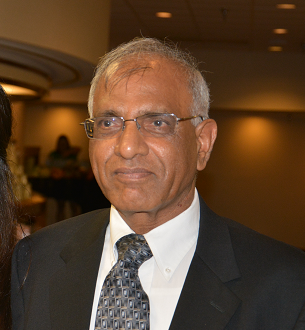
Junuthula N. Reddy is a Distinguished Professor, Regent's Professor, and inaugural holder of the Oscar S. Wyatt Endowed Chair in Mechanical Engineering at Texas A&M University, College Station, Texas, USA.[1] He is an authoritative figure in the broad area of mechanics and one of the researchers responsible for the development of the Finite Element Method (FEM). He has made significant seminal contributions in the areas of finite element method, plate theory, solid mechanics, variational methods, mechanics of composites, functionally graded materials, fracture mechanics, plasticity, biomechanics, classical and non-Newtonian fluid mechanics, and applied functional analysis. Reddy has over 620 journal papers and 20 books and has given numerous national and international talks. He served as a member of the International Advisory Committee at ICTACEM, in 2001 and keynote addressing in 2014.[2][3]
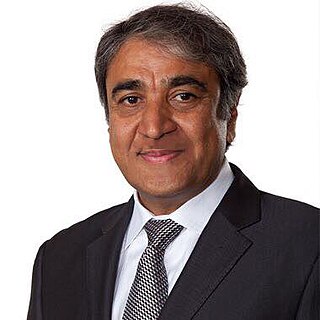
Pradeep Kumar Khosla is an Indian-American computer scientist and university administrator. He is the current chancellor of the University of California, San Diego.
The George Westinghouse Medal is named for George Westinghouse and awarded to in honor of "eminent achievement or distinguished service in the power field of mechanical engineering" by the American Society of Mechanical Engineers. There is a Gold medal and a Silver medal. The silver medal may only be awarded to someone under 45 years of age.
Larry L. Howell is a professor and Associate Academic Vice President (AAVP) at Brigham Young University (BYU). His research focuses on compliant mechanisms, including origami-inspired mechanisms, microelectromechanical systems, medical devices, space mechanisms, and developable mechanisms. Howell has also conducted research in lamina emergent mechanisms and nanoinjection. He received a bachelor's degree in mechanical engineering from BYU and master's and Ph.D. degrees from Purdue University. His Ph.D. advisor was Ashok Midha, who is regarded as the "Father of Compliant Mechanisms."

Bio-inspired robotic locomotion is a fairly new subcategory of bio-inspired design. It is about learning concepts from nature and applying them to the design of real-world engineered systems. More specifically, this field is about making robots that are inspired by biological systems, including Biomimicry. Biomimicry is copying from nature while bio-inspired design is learning from nature and making a mechanism that is simpler and more effective than the system observed in nature. Biomimicry has led to the development of a different branch of robotics called soft robotics. The biological systems have been optimized for specific tasks according to their habitat. However, they are multifunctional and are not designed for only one specific functionality. Bio-inspired robotics is about studying biological systems, and looking for the mechanisms that may solve a problem in the engineering field. The designer should then try to simplify and enhance that mechanism for the specific task of interest. Bio-inspired roboticists are usually interested in biosensors, bioactuators, or biomaterials. Most of the robots have some type of locomotion system. Thus, in this article different modes of animal locomotion and few examples of the corresponding bio-inspired robots are introduced.
The Holley Medal is an award of ASME for "outstanding and unique act(s) of an engineering nature, accomplishing a noteworthy and timely public benefit by one or more individuals for a single achievement, provided the contributions are equal or comparable."
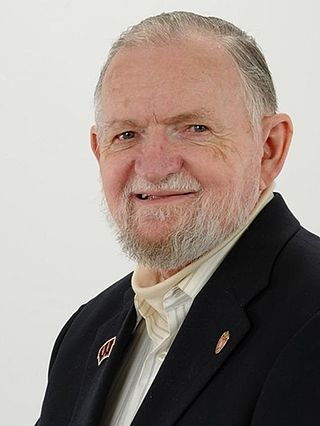
John J. Uicker, Jr was a professor of mechanical engineering at the University of Wisconsin-Madison, Wisconsin from 1967 to 2007 and professor emeritus from 2007 until his death in 2023.

Yoram Koren is an Israeli-American academic. He is the James J. Duderstadt Distinguished University Professor Emeritus of Manufacturing and the Paul G. Goebel Professor Emeritus of Engineering at the University of Michigan, Ann Arbor. Since 2014 he is a distinguished visiting professor at the Technion – Israel Institute of Technology.
Dawn Marie Tilbury is an American control theorist whose research topics include logic control, networked control systems, robotics, human–machine systems, and autonomous vehicles. She is a professor of mechanical engineering and of electrical engineering and computer science at the University of Michigan, and the head of the directorate for engineering at the National Science Foundation.

Ali Galip Ulsoy is an academic at the University of Michigan (UM), Ann Arbor, where he is the C.D. Mote, Jr. Distinguished University Professor Emeritus of Mechanical Engineering and the William Clay Ford Professor Emeritus of Manufacturing.







